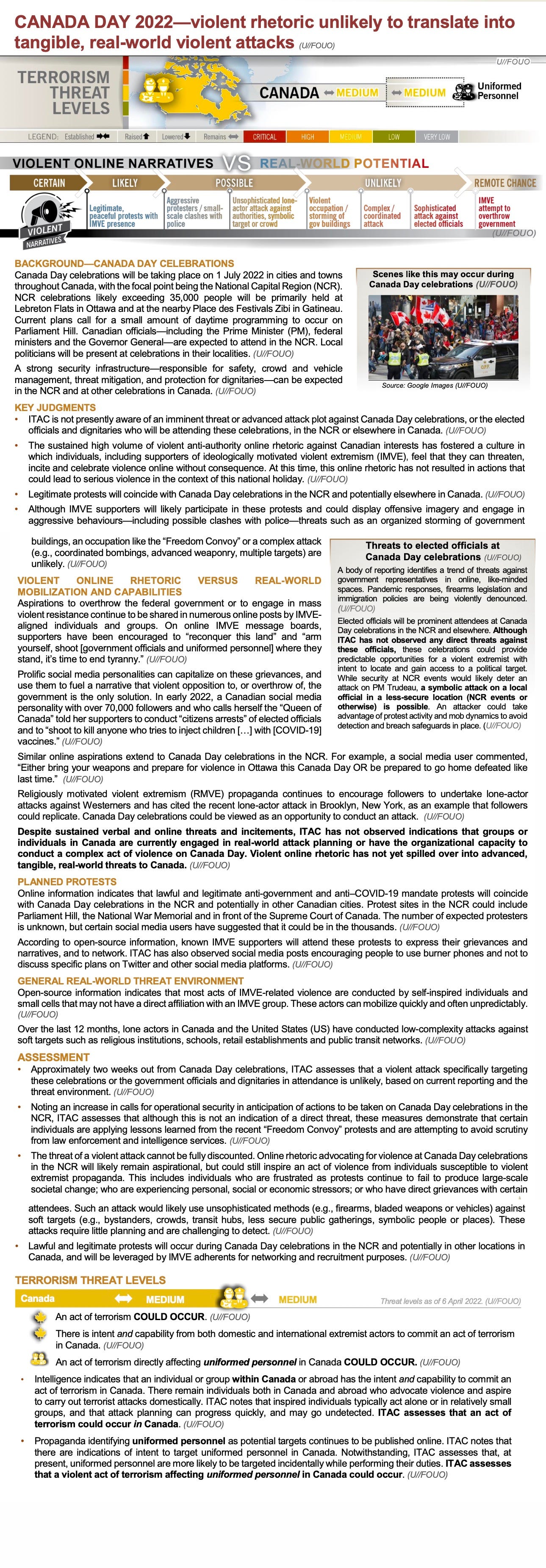Violent Online Narratives VS. Real-World Potential
A Canadian intelligence assessment grapples with whether increasingly violent rhetoric could lead to an actual attack
Greeting, readers — you’ve got another extra Bug-eyed and Shameless coming your way.
It’s been four months since Canadian police cleared out the occupation of downtown Ottawa, protesting everything from vaccine mandates, to vaccines themselves, and the supposed globalist cabal secretly running the country at the behest of World Economic Forum boss Klaus Schwab.
The outing marked an extraordinary meeting of a bunch of disparate anti-vaccine, conspiracy, and extremist groups. In the lead-up to their arrival, Canadian intelligence services worried it could be a prime recruiting ground for violent extremists.
Since they’ve left, however, we have not seen the kind of sustained action that we’ve been looking out for.
Certainly there were inspired events in the United States, Australia, and New Zealand — and successor events across Canada have sprung up in recent weeks. A bikers’ convoy to Ottawa attracted thousands of supporters, but lacked the oomph of the event in January.

Some of the individual players have tried to convert the momentum of the convoy into the political realm — two different pro-occupation political parties ran in Ontario’s provincial election this month, one even fielding convoy spokesman Tom Marazzo as a candidate. Between them, they netted about 200,000 votes across the province (that’s just under five percent of the vote.) That’s below what Maxime Bernier’s far-right People’s Party got in the province in the 2021 federal election.
Everyone is keeping their eyes fixed on the capital for Canada Day, July 1, which has long been rumoured as the next big attempt for the anti-vaccine movement to flex its muscles. Even though the majority of vaccine mandates and vaccine passports have been kiboshed, the movement is still demanding that anyone suspended or fired for refusing to be vaccinated be reinstated and compensated. At least, that’s their publicly-stated aim.
In reality, many of these groups have talked openly about their wish to see a tribunal struck that could prosecute public health officials and politicians for their role in encouraging vaccines. Some of those groups are getting increasingly vocal in that belief, and have begun to eschew the idea that the actions in Ottawa next week should remain peaceful. Radical elements are beginning to lose faith in the idea that, with enough protest, the country will see the error of their ways and ditch their faith in vaccines. They are no longer being coy about their desire to see regime change.
Clearly I’m not the only one keeping tabs on these folks with some concern.
Below is an intelligence assessment from the Integrated Terrorism Assessment Centre, one arm of Canada’s security services. While the Centre is housed within the Canadian Security Intelligence Service it doesn’t do any active spying itself. The Centre is primarily concerned with centralizing intelligence — largely open source, from publicly-available venues like social media — and sending it out to law enforcement partners across the country.
It’s an interesting document, because it really underscores how intelligence agencies are grappling with the complexity of these movements. The convoy, for example, had a shifting and oft-changing leadership structure, involving a litany of recently-created groups. At times, there appeared to be different factions rowing in different directions: Some willing to negotiate with police, some not. Most worryingly, there were small factions of extremists, including those with ties to militant and armed white nationalist and neo-Nazi groups.
Some have tried to paint the occupation as one or the other: Either entirely legitimate and peaceful, with extremist groups unwantedly riding their coattails; or as purely extremist, violent, and racist, with only the veneer of mainstream appeal.
As the Centre’s overview makes clear, it’s impossible to come to such sweeping conclusions. The reality is much more complicated. And that makes it very, very hard to figure out what comes next.
All that said, their assessment that the events — whatever they look like — are likely to remain peaceful strikes me as the right call. But, as they note, it only takes one person to change all that.
To other media: Feel free to share the contents of this bulletin, not the image of the bulletin itself, with credit.
Given this is as close as I’m going to get to a Canada Day-themed dispatch, here’s some Tragically Hip.


